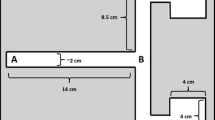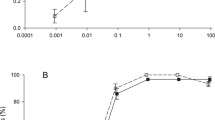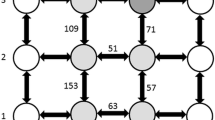Abstract
The behavior ofReticulitermes hesperus Banks pseudergates (workers) was assessed on artificial trails containing different concentrations of sternal gland extract. On nongiadient trails, more pseudergates were recruited to trails of greater pheromone concentration, they traveled a greater distance without pausing, and their rate of locomotion increased over that observed on trails of lesser concentration (positive orthokinesis). Of the individuals pausing before completing trails of high concentration, fewer left the trails or reversed direction (negative klinokinesis) than on trails of lower concentration. Termites walking down concentration gradients failed to complete these trails to the low-concentration termini. At a point representing an average decrease of slightly more than 10-fold in the original concentration of pheromone, individuals reversed their direction of travel and returned to the high-concentration terminus. Termites walking up pheromone gradients proceeded to the high-concentration termini without reversing direction.R. hesperus pseudergates are thus able to orient along a gradient of trail pheromone by longitudinal klinotaxis.
Similar content being viewed by others
References
Bossert, W.H., andWilson, E.O. 1963. The analysis of olfactory communication among animals.J. Theor. Biol. 5:443–469.
Conover, W.J., andIman, R.L. 1981. Rank transformations as a bridge between parametric and nonparametric statistics.Am. Stat. 35:124–129.
Dixon, W.J., andMassey, F.J. 1983. Introduction to Statistical Analysis. McGraw-Hill, New York. 678 pp.
Ewer, D.W., andBursell, E. 1950. A note on the classification of elementary behaviour patterns.Behaviour 3:340–347.
Grace, J.K. 1986. A simple humidity chamber for maintaining subterranean termites (Isoptera: Rhinotermitidae) in the laboratory.Pan-Pac. Entomol. 62:221–223.
Hall, P., andTraniello, J.F.A. 1985. Behavioral bioassays of termite trail pheromones: Recruitment and orientation effects of cembrene-A inNasutitermes costalis (Isoptera: Termitidae) and discussion of factors affecting termite response in experimental contexts.J. Chem. Ecol. 11:1503–1513.
Honda, R., Oshima, K., andYamamoto, I. 1975. Chemical nature of trail-following substance from a Japanese termite,Reticulitermes speratus Kolbe.J. Agric. Sci. Tokyo Univ. Agric. 20:121–128.
Howard, R., Matsumura, F., andCoppel, H.C. 1976. Trail-following pheromones of the Rhinotermitidae: Approaches to their authentication and specificity.J. Chem. Ecol. 2:147–166.
Jander, R., andDaumer, K. 1974. Guideline and gravity orientation of blind termites foraging in the open (Termitidae:Macrotermes, Hospitalitermes).Insectes Soc. 21:45–69.
Kaib, M., Bruinsma, O., andLeuthold, R.H. 1982. Trail-following in termites: Evidence for a multicomponent system.J. Chem. Ecol. 8:1193–1205.
Kennedy, J.S. 1978. The concepts of olfactory “arrestment” and “attraction.”Physiol. Entomol. 3:91–98.
Kennedy, J.S. 1986. Some current issues in orientation to odour sources, pp. 11–25,in T.L. Payne, M.C. Birch, and C.E.J. Kennedy (eds.). Mechanisms in Insect Olfaction. Oxford University Press, New York.
Kramer, C.Y. 1956. Extension of multiple range tests to group means with unequal numbers of replications.Biometrics 12:307–310.
Leuthold, R.H. 1975. Orientation mediated by pheromones in social insects, pp. 197–211,in C. Noirot, P.E. Howse, and G. Lemasne (eds.). Pheromones and Defensive Secretions in Social Insects. IUSSI, Dijon.
Liang, M.Y., Coppel, H.C., Matsumura, F., andEsenther, G. 1979. Exocuticular structures on the sternal gland segments of Rhinotermitidae.Sociobiology 4:169–190.
Matsumura, F., Coppel, H.C., andTai, A. 1968. Isolation and identification of termite trail-following pheromone.Nature 219:963–964.
Matsumura, F., Jewett, D.M., andCoppel, H.C. 1972. Interspecific response of termite to synthetic trail-following substance.J. Econ. Entomol. 65:600–602.
Mosconi-Bernardini, P., andVecchi, M.L. 1964. Osservazioni istologiche e flouromicroscopiche sulla ghiandola sternale diReticulitermes lucifugus (Rhinotermitidae).Symp. Genet. Biol. Ital. 13:169–177.
Prestwich, G.E., Eng, W.S., Deaton, E., andWichern, D. 1984. Structure-activity relationships among aromatic analogs of trail-following pheromone of subterranean termites.J. Chem. Ecol. 10:1201–1217.
Quade, D. 1966. On analysis of variance for thek-sample problem.Ann. Math. Stat. 37:1747–1758.
Quennedey, A. 1971. Les glandes exocrines des termites. Organisation de la glande sternale des Rhinotermitidae. Etude ultrastructurale preliminaire.C.R. Acad. Sci. Paris 273(D):376–379.
Ritter, F.J., andCoenen-Saraber, C.M.A. 1969. Food attractants and a pheromone as trail-following substance for the Saintonge termite: Multiplicity of the trail-following substances in L.trabea infected wood.Entomol. Exp. Appl. 12:611–622.
Runcie, C.D.M. 1983. Trail-laying and recruitment behavior in the subterranean termiteReticulitermes flavipes (Kollar) (Isoptera: Rhinotermitidae). PhD dissertation, University of North Carolina, Chapel Hill.
SAS Institute. 1982. SAS User's Guide: Statistics. SAS Institute, Inc., Cary, North Carolina.
Smythe, R.V., andCoppel, H.C. 1966. A preliminary study of the sternal gland ofReticulitermes flavipes (Isoptera: Rhinotermitidae).Ann. Entomol. Soc. Am. 59:1008–1010.
Traniello, J.F.A. 1982. Recruitment and orientation components in a termite trail pheromone.Naturwissenschaften 69:343–344.
Traniello, J.F.A., andBusher, C. 1985. Chemical regulation of polyethism during foraging in the neotropical termiteNasutitermes costalis.J. Chem. Ecol. 11:319–332.
Tschinkel, W.R., andClose, P.G. 1973. The trail pheromone of the termite,Trinervitermes trinervoides.J. Ins. Physiol. 19:707–721.
Van Vorhis Key, S.E., andBaker, T.C. 1982. Trail pheromone-conditioned anemotaxis by the Argentine ant,Iridomyrmex humilis.Entomol. Exp. Appl. 32:232–237.
Van Vorhis Key, S.E., Gaston, L.K., andBaker, T.C. 1981. Effects of gaster extract trail concentration on the trail following behaviour of the Argentine ant,Iridomyrmex humilis (Mayr).J. Insect Physiol. 27:363–370.
Author information
Authors and Affiliations
Rights and permissions
About this article
Cite this article
Grace, J.K., Wood, D.L. & Frankie, G.W. Trail-following behavior ofReticulitermes hesperus Banks (Isoptera: Rhinotermitidae). J Chem Ecol 14, 653–667 (1988). https://doi.org/10.1007/BF01013913
Received:
Accepted:
Issue Date:
DOI: https://doi.org/10.1007/BF01013913




